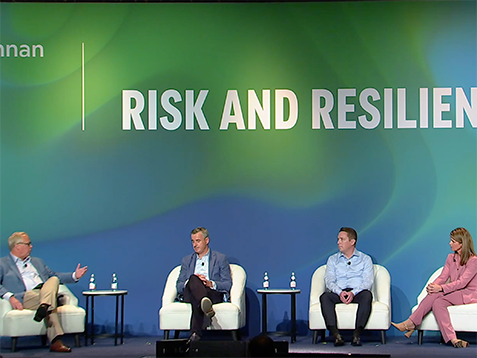Securities litigation trends suggest that IPOs attract more lawsuits than established public companies. According to the Securities Class Action Clearinghouse, since the financial crisis in 2008, almost one in five IPOs — 19.2% — have faced securities litigation within four years of their initial offering. In contrast, the average annual percentage of S&P 500 companies sued between 2009 and 2018 was 5.5%. In the first half of 2021, class-action filings involving SPACs increased by 14% from 2020.
One of the challenges for SPAC investors is the lack of transparency into acquisition targets. The de-SPAC process can potentially lead to allegations of conflict of interest, failure to disclose material risk factors, insufficient due diligence, overly lofty projections, and misrepresentations to stakeholders. Becoming public can expose flaws in the acquired company's business model, affecting its future growth and earnings, which in turn can erode value for its investors — and invite litigation against its directors and officers.
So far, a differentiating factor in successful de-SPACs is the sponsor's level of experience in the acquired business. Even if a SPAC sponsor and its board members are highly experienced, competition for targets and the pressure to consummate a deal in the 24-month timeframe may result in a decision to pursue a bad deal rather than walk away. This can also lead to liability exposure.
In April 2021, the chairman, chief executive officer, and chief financial officer of a SPAC were named in a class-action lawsuit brought by an investor. The suit alleged the individual defendants controlled or possessed the authority to control the content of reports, press releases, and investor presentations, and had made materially false and misleading statements. The plaintiff is seeking a jury trial to determine compensatory and punitive damages from all defendants, jointly and separately. The case is pending in a federal district court.1
Considerations for SPAC Participants
Before participating in a SPAC, individuals and family offices should consider questions to inform their decision, and help avoid exposing themselves to potential liability concerns. Some of these considerations include:
- What is the motivation to participate in the SPAC? Understanding the reasons to participate — financial prospects, aligned interests or specialization, or professional growth opportunity, perhaps — is a first step in assessing the risks. Without clear motivation and direction, the risk of participating (i.e., the personal exposure assumed by joining) may outweigh the position. Helping a friend or family member is not an ideal reason to participate by itself.
- What is the sponsor's background? Professionals with investment experience and knowledge of public companies are more likely to enlist qualified legal, accounting, and audit advisors to conduct adequate due diligence. A failure to identify problems during due diligence is a major factor in litigation.
- What kinds of targets does the SPAC intend to acquire? Knowledge of the target sector can be a major advantage, just as a lack of familiarity with targeted businesses can lead to poor financial performance.
- How will the SPAC identify and resolve conflicts of interest? The makeup of the board, the target's executive team, and the SPAC's acquisition approach may lead to real or perceived conflicts of interest. These should be disclosed in the SPAC's own IPO documents, but board members should strive to understand these and how any conflicts will be resolved.
- Are the targets in the United States or another jurisdiction? Non-U.S. jurisdictions are seeing increased interest in SPACs, but acquiring companies internationally may trigger tax, accounting, and regulatory requirements. Participants should make sure to consult qualified advisors in these areas.
- Is the SPAC sponsor willing to abandon a prospective acquisition? Willingness to walk away from a bad deal and refund investors' money can be a positive sign indicating that the SPAC sponsor is approaching investments prudently and is not caught up in irrational exuberance.
- How is the SPAC's D&O liability insurance program structured? The lack of D&O insurance for the SPAC entity should be a red flag, but other considerations include the amount of coverage, whether the limits are shared with the entity, and how long coverage is available (see sidebar).
How SPACs can optimize D&O coverage
SPAC boards should have directors and officers (D&O) liability insurance commensurate with their exposures. A thorough understanding of the risks is essential to constructing an optimal risk management program and making sure there is adequate insurance.
D&O insurance comes in three types, known as sides. Side A protects individual directors and officers when the company cannot or will not indemnify them. Side B reimburses the company for indemnifying the directors and officers. Side C provides coverage for the entity itself in securities claims. It is common for public companies to buy all three types, but depending on the program structure, one set of limits may apply. This situation can erode the protection available to Side A claims against directors and officers.
Another consideration for SPACs is the tail period following the de-SPAC. Generally, SPAC directors and officers can be the target of securities lawsuits for up to six years once the SPAC makes an acquisition. If coverage is not in place for the duration of this tail period, the directors' and officers' personal assets may be at risk.
With operating companies, a strong balance sheet can be a comfort to directors and officers concerned about indemnification. SPACs, however, have far smaller balance sheets because they typically do not maintain significant amounts of working capital during the investment period. SPAC directors and officers, therefore, should not rely on the SPAC's balance sheet to provide indemnification. For these reasons, directors and officers should insist on adequate D&O insurance in all phases of the SPAC.
Recommendations
Special purpose acquisition companies offer opportunities to affluent families and family offices, but they also come with risks. Before deciding to participate in a SPAC as a director, officer, or investor, seek advice from qualified professionals who can help assess the risks and exposures, and provide guidance on how to manage them and protect yourself, your family, and your financial future. There are various insurance solutions available to provide coverage — including a unique solution Marsh crafted to provide extended coverage through the de-SPAC phase — depending on your needs.
If you or your family office are considering investing or becoming involved in a SPAC, contact your personal risk advisor at Marsh McLennan Agency Private Client Services.





